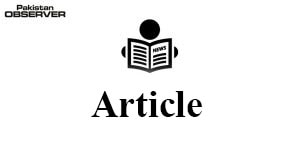Maryam Anas Ganaie
SLOWDOWN in economic activity due to COVID-19 pandemic, interms of trade has affected businesses especially SMEs worldwide. Sealed borders, trade inter-dependencies, export restrictions for maintaining stock of critical products to deal with pandemic have changed global trade practices. Around 94 countries adopted export restriction measures and 104 countries adopted import liberalization strategy to survive during COVID-19 pandemic.
As a result, global trade decreased by 4.5% in the third quarter of 2020 as compared to the same period of preceding year. Overall export of Pakistan declined by 7.2% during July 2019- June 2020 and remained at US $ 21.29 billion as compared to US$ 22.95 billion during the corresponding period last year. However, Pakistan’s exports have shown some positive sign of recovery as exports increased by 2.2% during July-November 2020 as compared with the export growth of the same period of preceding year.
Nevertheless, every challenging situation also brings opportunities. The current pandemic has opened new avenues of investment, change in business operations, product transformation and adoption of new business models to address the changing demands of consumer market. A country like Pakistan that has abundance of natural and human resources should take steps to exploit these opportunities in order to become self-reliant. Naturally, SMEs have an important role to play in this regard. Currently, there is a huge market demand for medical and related products, so countries around the world are assessing the possibility to divert production towards producing certain health-related goods in close proximity of their own market competencies. The strategic importance given to the medical supply sector is likely to remain in the near future.
Pakistan needs to exploit the vast opportunities of increasing exports in the health and safety products like personal protective equipment (PPE), including protective masks, gloves, sanitizers, clothing, helmets, goggles and other garments or equipment designed for protection from COVID -19 To support trade flow critical products to deal with pandemic, the World Health Organization (WHO) has identified and published list of critical products for exports, out of which 57 tariff lines at 6-digit HS are close to Pakistan’s competency. These products mainly include anti-epidemic goods (disinfectants, toilet papers, cleaning products etc), raw material for masks (fabric, aluminum and steel rods), medical equipment (instruments, appliances, machines, articles for the conveyance or packaging of goods, of plastics (excluding boxes, cases, crates etc), Medical Supplies (protective kits, suits, masks, Hats and other headgear, Surgical gloves, of vulcanized rubber, Wadding, gauze, bandages , other garments) and food products ( meat, rice, flour, nuts, fruits and vegetables etc). Currently, Pakistan’s export of identified 57 tariff lines stands at US$ 4 billion. Pakistani exporters must exploit trade opportunities emerging from the crisis by targeting a range of products that are close to their production line.
Furthermore, almost half of Pakistan’s exports are directed to the countries most affected by Coronavirus. Approximately 40% of exports from Pakistan are destined for affected western countries UK, US, France, Italy, Spain and Germany. These countries have opened up their borders for masks, protective kits, sanitizers and other products that offer an opportunity for Pakistan to enhance its exports in order to compensate low exports of traditional products to these destinations.
In this regard, Government may need to support local SMEs to exploit this opportunity through providing facilitative business environment, fiscal support, provision of raw material etc. In addition, support may also be provided to meet quality and standardization requirements. Similarly, measures may also be taken to enhance export of food products to traditional and non-traditional markets. Now, the economies of the western world, that are important destinations for finished products belonging to the textile and leather industries, are in revival phase.
Their economic revival will be crucial for Pakistan’s exports and will offer greater market opportunities for local manufacturers and traders. It is essential that the government may adopt sector specific strategy to facilitate potential sectors for export promotion purposes. Pakistan may also need to adopt long term industrial and trade strategy to provide essential economic support to businesses in post COVID-19 period.
There is a need to focus on strengthening local industry to cater consumer market demand, capturing new markets and creating job opportunities for those who lost their jobs during COVID-19 pandemic. The philosophy of “Make in Pakistan” should be promoted by adopting import substitution strategy.
—The writer is Assistant Manager in Policy & Planning Division of SMEDA.










